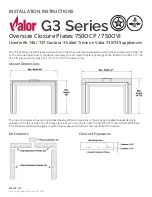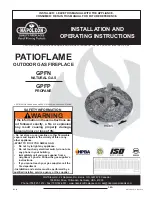
EXHAUSTO
A
PPENDIX
A: D
ESIGN
T
HEORY
Fireplaces with natural draft chimneys follow the
same gravity fluid flow law as gas vents and thermal
flow ventilation systems.
To a certain degree, mass flow of hot flue gases
through a vertical pipe is a function of the heat release,
the chimney area, height, and the flow resistance
(system pressure loss coefficient).
Consequently, standard sizing of chimneys must
include an estimate of the flue gas volume and the
available draft. Available draft is the difference be-
tween the natural draft and the system pressure loss.
The available draft must be negative for the system to
work.
There are limitations to this approach. A lot can be
determined and explained via calculations, but some
factors must be determined by adding the use of
experience and common sense. The location of a
building, the existence of cross winds, eddies etc. are
examples of such factors. These factors can be ex-
pressed as pressure losses, but it is not easy to put a
value to them.
The flue gas volume depends on the fuel burned
and the amount of air used for the combustion.
The general method to determining the flue gas
volume is to base the calculation on the air require-
ments for the combustion.
The air requirement is found by determining the
area of the air inlet and multiplying this with the frontal
inlet velocity.
As the air expands when it is warmed up over the
fire, the actual flow in the chimney is dependent on the
temperature in the chimney.
Normally, a 300°F mean gas temperature rise
above ambient (usually 60°F) is used as a guideline,
and with this temperature rise, the air will expand with
almost 60%.
The following are examples of how the flue gas
volume can be determined for different applications.
Estimating Flow
The combustion air requirement can be determined
using this formula:
Q
t
= q x A
inlet
x V
inlet
144
Q
t
= Flow @ t°F (CFM, or cubic feet per minute)
A
inlet
= Area of opening (square inches)
V
inlet
= Frontal inlet velocity (FPM, or feet per minute)
q
= Expansion factor
Flow in one-sided fireplaces used for solid fuel.
In a one-sided fireplace a frontal inlet velocity of 36-
48 FPM (feet per minute) with a mean chimney tem-
perature of min. 300°F should provide a good combus-
tion and a well-working fireplace.
Example: Fireplace height is 24", width is 36" and
the frontal inlet velocity is estimated at 48 FPM.
The flow into the firebox is:
Q
60
= 24x36 x 48 CFM
= 288 CFM
144
The expansion factor is 1.6 at 300°F, so the flue gas
volume in the flue is:
Q
300
= 288 CFM x 1.6 = 460 CFM
In other words, a wood-fired fireplace with a 2' x 3'
opening produces 460 CFM of flue gas (flow) at an
average flue gas temperature of 300°F.
Flow in one-sided fireplaces used for gas.
In a one-sided fireplace used for gas firing, a frontal
velocity of 18-36 FPM with a mean chimney tempera-
ture of min. 200°F should provide a well-working fire-
place.
The combustion air requirement can be determined
by using the formula for wood-fired fireplaces.
Example: The previous example used for gas,
gives this volume into the firebox:
Q
60
= 24 x 36 x 36 CFM = 216 CFM
144
The expansion factor at 200°F is 1.4, so the flue gas
volume in the flue is:
Q
200
= 216 CFM x 1.4 = 302 CFM
A gas-fired fireplace produces less flue gas volume
than a wood-fired.
It is worthwhile noticing that the input of gas logs or
gas burner has no major impact on the flue gas volume
in an open fireplace.
Flow in open fireplaces without smoke
chamber.
If the fireplace does not have a smoke chamber, or
if the smoke chamber is very small, it is wise to use a
higher frontal inlet velocity - preferably in the range 48-
84 FPM.
21
Содержание EXHAUSTO RS 12
Страница 21: ...Appendix EXHAUSTO 20 NorthlineExpress com http www northlineexpress com Toll Free 1 866 667 8454 ...
Страница 33: ...EXHAUSTO 33 Notes NorthlineExpress com http www northlineexpress com Toll Free 1 866 667 8454 ...
Страница 34: ...EXHAUSTO 34 Notes NorthlineExpress com http www northlineexpress com Toll Free 1 866 667 8454 ...
Страница 35: ...EXHAUSTO 35 Notes NorthlineExpress com http www northlineexpress com Toll Free 1 866 667 8454 ...














































